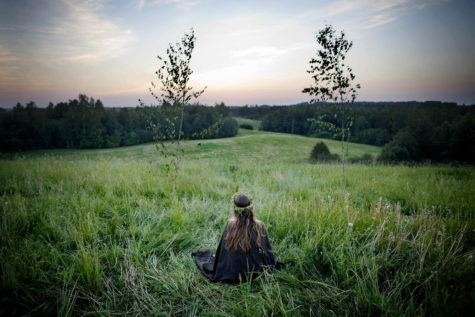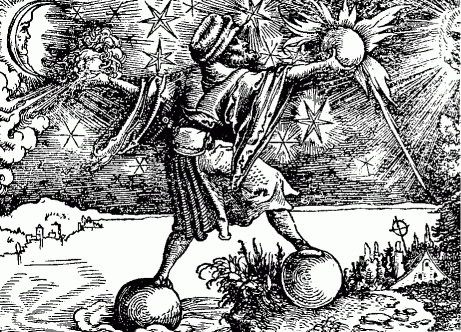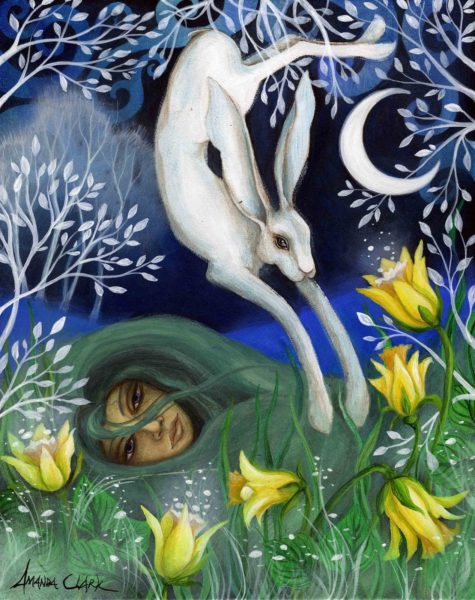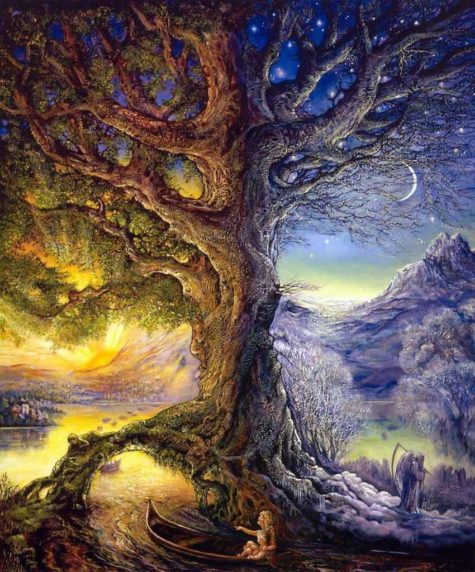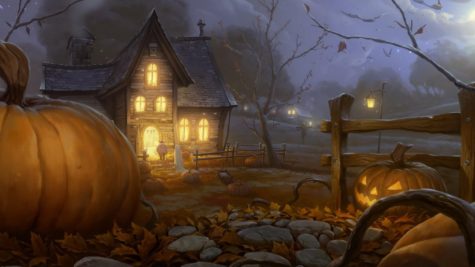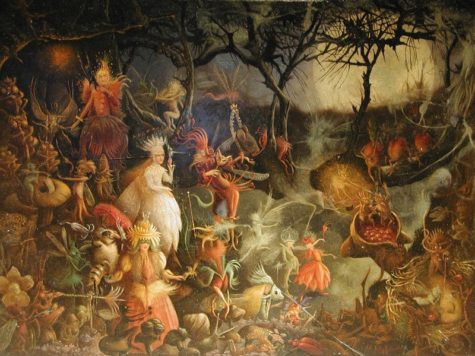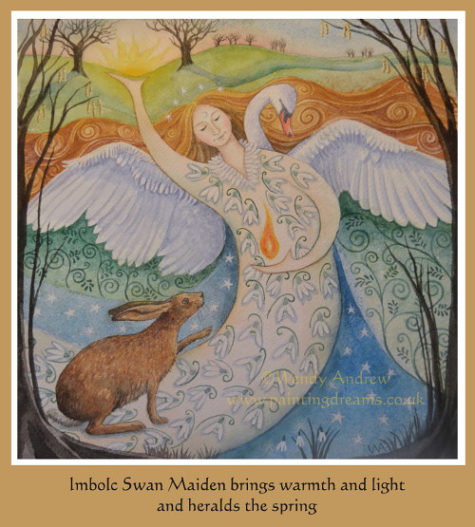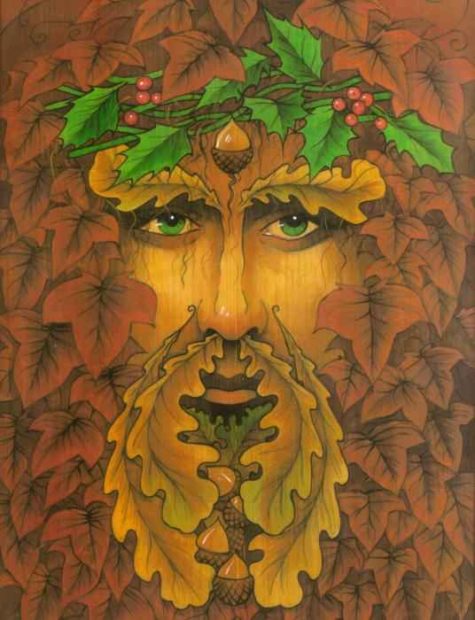Wheel of the Year
Although Midsummer Day occurs at the summer solstice, or what we think of as the beginning of summer, to the farmer it is the midpoint of the growing season, halfway between planting and harvesting, and an occasion for celebration.
The most common other names for this holiday are the Summer Solstice or Midsummer, and it celebrates the arrival of Summer, when the hours of daylight are longest. The Sun is now at the highest point before beginning its slide into darkness.
Celebrating Midsummer Day
Although it’s also the feast day of St. John the Baptist, it features pagan traditions such as bonfires, fire walking, and a carnival atmosphere, all of which took place on Midsummer Eve. Certainly, it’s a night of magic and soothsaying as well, for as Washington Irving said, this is a time “when it is well known all kinds of ghosts, goblins, and fairies become visible and walk abroad.” After Midsummer Day, the days shorten.
In Sweden and Norway at the Solstice, people made wheels of fortune. Some of the wheels were wrapped in straw, set on fire, and rolled down hill. Other wheels were decorated and kept. These were used in two ways: One, the wheel was rolled away from a person to take away misfortunes; two, it was rolled toward a person to bring all kinds of good fortune.
Variations on the Midsummer celebrations:
People around the world have observed spiritual and religious seasonal days of celebration during the month of June. Most have been religious holy days which are linked in some way to the summer solstice.
- Scottish Pecti-Witans celebrate Feill-Sheathain on July 5th.
- In the Italian tradition of Aridian Strega, this Sabbat (Strega Witches call them Treguendas rather than Sabbats) is known as Summer Fest – La Festa dell’Estate.
- Scandinavians celebrate this holiday at a later date and call it Thing-Tide.
- In England, June 21st is “The Day of Cerridwen and Her Cauldron”.
- In Ireland, this day is dedicated to the faery goddess Aine of Knockaine.
- June 21st is “The Day of the Green Man” in Northern Europe.
In Lithuanian tradition, the dew on Midsummer Day was said to make young girls beautiful and old people look younger. It was also thought that walking barefoot in the dew would keep one’s skin from getting chapped.
It was customary to honor all men named John on this day by fixing wreaths of oak leaves around their doors. This is usually done in secret, and John must guess who did it or catch the person in the act, in which case he must give the person a treat.
Midsummer Celebrations in Ancient Times:
The solstice itself has remained a special moment of the annual cycle of the year since Neolithic times. The concentration of the observance is not on the day as we reckon it, commencing at midnight or at dawn, but the pre-Christian beginning of the day, which falls on the previous eve. Other names for this time in the Wheel of the Year include:
- Alban Heruin (Caledonii or the Druids)
- Alban Hefin (Anglo-Saxon Tradition)
- Sun Blessing, Gathering Day (Welsh)
- Whit Sunday, Whitsuntide (Old English)
- Vestalia (Ancient Roman)
- Feast of Epona (Ancient Gaulish)
- All-Couple’s Day (Greek)
Ancient Celts: Druids, the priestly/professional/diplomatic corps in Celtic countries, celebrated Alban Heruin (“Light of the Shore”). It was midway between the spring Equinox (Alban Eiler; “Light of the Earth”) and the fall Equinox (Alban Elfed; “Light of the Water”). “This midsummer festival celebrates the apex of Light, sometimes symbolized in the crowning of the Oak King, God of the waxing year. At his crowning, the Oak King falls to his darker aspect, the Holly King, God of the waning year…” The days following Alban Heruin form the waning part of the year because the days become shorter.
Ancient China: Their summer solstice ceremony celebrated the earth, the feminine, and the yin forces. It complemented the winter solstice which celebrated the heavens, masculinity and yang forces.
Ancient Egypt:In Ancient Egypt, summer solstice was the most important day of the year. The sun was at its highest and the Nile River was beginning to rise. Special ceremonies were held to honor the Goddess Isis. Egyptians believed that Isis was mourning for her dead husband, Osiris, and that her tears made the Nile rise and well over. Accurately predicting the floods was of such vital importance that the appearance of Sirius, which occurs around the time of the summer solstice, was recognized as the beginning of the Egyptian New Year.
Ancient Gaul: The Midsummer celebration was called Feast of Epona, named after a mare goddess who personified fertility, sovereignty and agriculture. She was portrayed as a woman riding a mare.
Ancient Germanic, Slav and Celtic tribes in Europe: Ancient Pagans celebrated Midsummer with bonfires. “It was the night of fire festivals and of love magic, of love oracles and divination. It had to do with lovers and predictions, when pairs of lovers would jump through the luck-bringing flames…” It was believed that the crops would grow as high as the couples were able to jump. Through the fire’s power, “…maidens would find out about their future husband, and spirits and demons were banished.” Another function of bonfires was to generate sympathetic magic: giving a boost to the sun’s energy so that it would remain potent throughout the rest of the growing season and guarantee a plentiful harvest.
Ancient Rome: The festival of Vestalia lasted from June 7 to June 15. It was held in honor of the Roman Goddess of the hearth, Vesta. Married women were able to enter the shrine of Vesta during the festival. At other times of the year, only the vestal virgins were permitted inside.
Ancient Sweden: A Midsummer tree was set up and decorated in each town. The villagers danced around it. Women and girls would customarily bathe in the local river. This was a magical ritual, intended to bring rain for the crops.
Information collected from various sources
Notes: I am assuming that this counting of the days begins and ends with the new moon. Notice that there are 29 days listed even though it only takes the moon 27.3 days to orbit the earth. I also found the juxtaposition of the Major Arcana of the Tarot with Old Testament happenings, and the Goddess Hecate (see day 27), an interesting mix.
1. The Juggler, or Magus— The first day of the moon is that of the creation of the moon itself. This day is consecrated to mental enterprises, and should be favorable for opportune innovations.
2. Pope Joan, or Occult Science — This day is propitious to revelations, initiations, and great discoveries of science.
3. The Celestial Mother, or Empress— The third day was that of man’s creation. So is the moon called the MOTHER in Kabbalah, when it is represented in association with the number three. This day is favorable to generation, and generally to all productions, whether of body or mind.
4. The Emperor, or Ruler— The fourth day is baleful; it was that of the birth of Cain; but it is favorable to unjust and tyrannical enterprises.
5. The Pope, or Hierophant— The fifth day is fortunate; it was that of the birth of Abel.
6. The Lover, or Liberty— The sixth is a day of pride; it was that of the birth of Lamech, who said unto his wives; “I have slain a man to my wounding, and a young man to my hurt. If Cain shall be avenged sevenfold, truly Lamech seventy and sevenfold.” This day is propitious for conspiracies and rebellions.
7. The Chariot— On the seventh day, birth of Hebron, who gave his name to the first of the seven sacred cities of Israel. A day of religion, prayers and success.
8. Justice— Murder of Abel. Day of expiation.
9. The Old Man, or Hermit— Birth of Methucelah. Day of blessing for children.
10. Ezekiel’s Wheel of Fortune— Birth of Nebuchadnezzar. Reign of the Beast. Fatal day.
11. Strength— Birth of Noah. Visions on this day are deceitful, but it is one of health and long life for children born on it.
12. The Victim, or Hanged Man— Birth of Samuel, Prophetic and kabbalistic day, favorable to the fulfilment of the great work.
13. Death— Birthday of Canaan. the accursed son of Cham. Baleful day and fatal number.
14. The Angel of Temperance— Blessing of Noah on the fourteenth day of the moon. This day is governed by the angel Cassiel of the hierarchy of Uriel.
15. Typhon, or the Devil— Birth of Ishmael. Day of reprobation and exile.
16. The Blasted Tower— Birthday of Jacob and Esau; the day also of Jacob’s predestination, to Esau’s ruin.
17. The Glittering Star— Fire from heaven burns Sodom and Gomorrah. Day of salvation for the good, and ruin for the wicked; on a Saturday dangerous. It is under the dominion of the Scorpion.
18. The Moon— Birth of Isaac. Wife’s triumph. Day of conjugal affection and good hope.
19. The Sun— Birth of Pharaoh. A beneficent or fatal day for the great of earth, according to the different merits of the great.
20. The Judgment— Birth of Jesus, the instrument of God’s judgment. Propitious for divine revelations.
21. The World— Birth of Saul, material royalty. Danger to mind and reason.
22. Influence of Saturn— Birth of Job. Day of trial and suffering.
23. Influence of Venus— Birth of Benjamin. Day of Preference and tenderness.
24. Influence of Jupiter— Birth of Japhet.
25. Influence of Mercury— Tenth plague of Egypt.
26. Influence of Mars— Deliverance of the Israelites, and passage of the Red Sea.
27. Influence of Diana, or Hecate— Splendid victory achieved by Judas Maccabeus.
28. Influence of the Sun— Samson carries off the gates of Gaza. Day of strength and deliverance.
29. The Fool of the Tarot— Day of failure and miscarriage in all things.
Found in:
Encyclopaedia of Superstitions, Folklore, and the Occult Sciences of the World
Also known as: Oestre, Easter, the Spring Equinox, Vernal (Spring) Equinox, Alban Eiler (Caledonii), Méan Earraigh
- March 20 – 23 Northern Hemisphere
- September 20 – 23 Southern Hemisphere
This is the official return of the young Goddess after her Winter hibernation. As with the other Equinox and the Solstices, the date of this festival may move slightly from year to year, but many will choose to celebrate it on 21 March.
The Spring Equinox is the point of equilibrium – when light and darkness are in balance but the light is growing stronger. The balance is suspended just before spring bursts forth from winter. Night and day are of equal length at the equinox, the forces of male and female are also in balance. Ostara is a festival of balance and fertility.
In keeping with the balance of the Equinox, Oestara is a time when we seek balance within ourselves. It is a time for throwing out the old and taking on the new. We rid ourselves of those things which are no longer necessary – old habits, thoughts and feelings – and take on new ideas and thoughts. This does not mean that you use this festival as a time for berating yourself about your ‘bad’ points, but rather that you should seek to find a balance through which you can accept yourself for what you are.
It is also a celebration of birth and new life. A day when death has no power over the living.
Spring has arrived, and with it comes hope and warmth. Deep within the cold earth, seeds are beginning to sprout. In the damp fields, the livestock are preparing to give birth. In the forest, under a canopy of newly sprouted leaves, the animals of the wild ready their dens for the arrival of their young. Spring is here.
It is no coincidence that the name for this sabbat sounds similar to the word ‘Easter’. Eostre, or Ostara, is an Anglo-Saxon Dawn Goddess whose symbols are the egg and the hare. She, in turn, is the European version of the Goddess Ishtar or Astarte, whose worship dates back thousands of years and is certainly pre-Christian. Eostre also lives on in our medical language in the words ‘oestrous’ (the sexual impulse in female animals) and ‘oestrogen’ (a female hormone).
Today, Oestara is celebrated as a spring festival. Although the Goddess put on the robes of Maiden at Imbolg, here she is seen as truly embodying the spirit of spring. By this time we can see all around us the awakened land, the leaves on the trees, the flowers and the first shoots of corn.
There is some debate as to whether Oestara or Imbolg was the traditional time of spring cleaning, but certainly the casting out of the old would seem to be in sympathy with the spirit of this festival and the increased daylight at this time encourages a good clean out around the home.
The Easter Bunny also is of Pagan origin, as are baskets of flowers. Brightly colored eggs represent the child within.
Traditionally, Ostara is a time for collecting wildflowers, walking in nature’s beauty and cultivating herb gardens. Half fill a bowl with water and place a selection of flowers into it for display in a prominent position in your home.
This is the time to free yourself from anything in the past that is holding you back.
Sources: varied
And frosts are slain and flowers begotten,
And in green underworld and cover
blossom by blossom the spring begins.
~Algernon Charles Swinburne
Méan Earraigh marks the spring equinox, when night and day are of equal length and spring officially begins. Birds begin their nesting and egg-laying, and eggs–symbolic of rebirth, fertility, and immortality–are tossed into fresh furrows or eaten by ploughmen. They are also carried by those engaged in spring planting.
A charming custom is painting eggs with symbols and pictures of what one wishes to manifest in the coming year. The eggs can then be buried in the Earth Mother, who hears the cries and dreams of her children. In some communities, eggs are hidden in the stores of seed grain and left there all season to bless the sowing and encourage the seeds to sprout. Dressed as mummers, “pace-eggers” go from house to house and demand eggs and coins in return for a short performance. Men and women exchange clothing for the show.
The eggs given to the pace-eggers have been wrapped in leaves, roots, flowers, and bark before boiling, to impart color. Later the eggs are used in games, such as attempting to strike an opponent’s legs. The eggs might be hidden or rolled down hillsides, after which they are eaten. Blood, ashes from sacred fires, fistfuls of salt, or handfuls of soil from a high mountaintop are scattered on the newly sown fields.
Offerings of food and milk are left for the faeries and other spirits who live in and around rocks and are responsible for the fertility of the land. A few fruits from the previous year’s harvest are left for the nature spirits. Sacred hilltops are visited, and picnics of figs, fig cakes, cider and ale are enjoyed. The figs are symbolic of fertility, the leaf being the male element and the fruit the female.
You can also celebrate the arrival of spring with flowers. Bring them into your own home and give them to others. You do not have to spend a lot of money – one or two blooms given for no other reason than ‘spring is here’ can often bring a smile to even the most gloomy face.
A traditional Vernal Equinox pastime is to go to a field and randomly collect wildflowers (thank the flowers for their sacrifice before picking them). Or, buy some from a florist, taking one or two of those that appeal to you. Then bring them home and divine their Magickal meanings by the use of books, your own intuition, a pendulum, this post on the Magickal Meanings of Flowers, or by other means. The flowers you’ve chosen reveal your inner thoughts and emotions.
In the druidic tradition, Aengus Og is the male deity of the occasion. Son of In Dagda and Boand, he was conceived and born while Elcmar, Boand’s husband, was under enchantment. When three days old, Aengus was removed to be fostered by Midir, god of the Otherworld mound at Bri Leith, with his three hostile cranes. These birds guarded the mound and prevented the approach of travelers, and were said to cause even warriors to turn and flee.
Make an Altar to Ostara.
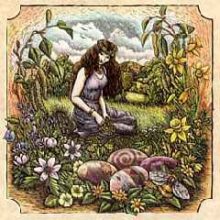 Ostara, the ancient German Virgin Goddess of Spring, loves bright colors. The light pastels of spring are perfect offerings for Ostara. To represent earth on your altar, choose bright or pastel colored stones like Rose Quartz, Amethyst, or any of the Calcites (blue, red, yellow, or green). If you have some Citrine, be sure to include it. Citrine has long been an aid for mental clarity.
Ostara, the ancient German Virgin Goddess of Spring, loves bright colors. The light pastels of spring are perfect offerings for Ostara. To represent earth on your altar, choose bright or pastel colored stones like Rose Quartz, Amethyst, or any of the Calcites (blue, red, yellow, or green). If you have some Citrine, be sure to include it. Citrine has long been an aid for mental clarity.
By including an offering of colored eggs on your altar, you will be taking part in an ancient tradition (still performed!) by the Germanic people. Ostara has been honored this time of year with painted eggs for centuries.
To symbolize fertility, in addition to the eggs, you can include seeds or rice on your altar. I like to use rice as a symbol for fertility on my altars.
Incense and feathers are perfect symbols for air on your altar. It is important for Ostara’s altar that you include a symbol for air because Ostara herself is the living symbol for Air. (This must be the way Ostara and Easter became associated with birds, i.e. chickens) Be sure to burn incense at your altar when you are dedicating it to bring in the energy and vibrational qualities of Ostara.
The perfect time to dedicate your altar is at dawn. Choose a day, then plan to dedicate your altar to Ostara at dawn’s first light by lighting incense and repeating an invocation to her as well as a prayer of thanksgiving for all that Ostara symbolizes in your life:
- A clear mind.
- New beginnings.
- Personal renewal.
- Fertility, either for the purpose of bearing a child or for creativity such as arts and crafts, writing, or decorating.
You can include anything you like on your altar to Ostara. You will know by how you feel if an item is appropriate or not. I believe it is important to include symbols for the four elements on my altars. The four elements are Fire, Earth, Air, and Water. The four Calcites on my altar (red/fire, green/earth, yellow/air, and blue/water) represent Mother Earth and the four elements. I have added feathers and other items that symbolize Ostara to my altar as offerings to her.
Last, but not least, it might be nice to include a figure of a rabbit. The rabbit is Ostara’s power animal. I am sure this is because of their propensity for fertility.
Sources:
Halloween or All Hallow’s Eve occurs on October 31, and originated with the ancient Celts, who, beginning at sundown on October 31 and extending into November 1, celebrated Samhain (pronounced sow-in, which rhymes with cow-in), which marked the end of harvest time and the beginning of the new year. The ancient Celts believed that at this time, the veil between the worlds of the living and the dead was at its thinnest, thereby making it a good time to communicate with the deceased and to divine the future.
In later years, the Irish used hollowed-out, candlelit turnips, carved with a demon’s face to frighten away the spirits. When Irish immigrants in the 1840s found few turnips in the United States, they used the more plentiful pumpkins instead.
Halloween activities include:
- Trick-or-treating (going door to door in costume and asking for treats)
- Attending Halloween costume parties
- Decorating, carving pumpkins into jack-o’-lanterns
- Lighting bonfires
- Apple bobbing
- Divination games
- Playing pranks
- Visiting haunted attractions
- Telling scary stories and watching horror films.
In many parts of the world, the Christian religious observances of All Hallows’ Eve, including attending church services and lighting candles on the graves of the dead, remain popular, although elsewhere it is a more commercial and secular celebration. Some Christians historically abstained from meat on All Hallows’ Eve, a tradition reflected in the eating of certain foods on this vigil day, including apples, potato pancakes and soul cakes.
Related Content:
The celebrations on the eve of All Souls Day, called Halloween, (October 31), stem from the Celtic New Year celebration called Samhain. When the Sun goes down on this eve, there is a time between the old year and the creation of the new. Specifically, this occurs at sunrise.
In this twilight of the years, the veil between this world and the world of the spirit is thin. It is a time when ghosts and spirits can interact with the living, and a time when divination is most effective. This is a sacred time when all warriors were to keep their swords sheathed.
Samhain literally means “end of the summer.” This day marked the last harvest of the summer, and so it is a harvest celebration. But, because there were only three months in the ancient Celtic calendar, and no autumn, it is also the beginning of the winter death that will lead to next year’s regeneration.
Ancient Celts believed that at Samhain, the veil between the worlds of the living and the dead was extremely thin, allowing the dead to cross over into the world of the living. Sometimes they appeared as apparitions and sometimes in the form of animals, most particularly black cats. The living lit bonfires and dressed in costumes to confuse the spirits and keep them from re-entering the world. On this night, the lord of death reigns, and the Celts protect themselves from this threat with bonfires and animal sacrifice. Animal sacrifice is closely associated with divination.
In most ancient cultures, the remains of the sacrificed animal were examined to discover the will of the gods and to predict the future. The Druid priests would take advantage of this auspicious time to look into the events of the upcoming year—at least up until Beltane, which marked the year’s midpoint.
Although predicting the future is not necessarily the best use of the tarot, this is a good time to try reading the future. You can do this by laying out three cards for each of the six months from Samhain to Beltane (you should have eighteen total cards). Read each set of three cards as a story that will pertain to that month.
During the period of Samhain, the time when the world of the living is closest to the world of the dead, it is often a good idea to make offerings to the spirits to keep them from doing harm. Traditionally on Halloween night, gifts of milk and barley are left out beneath the stars to acquire the blessings of ghosts and prevent them from harming your household.
Other traditions involve leaving a plate of food outside the home of the souls of the dead. A candle placed in the window guides them to the lands of eternal summer, and burying apples in the hard-packed earth “feeds” the passed ones on their journey.
For food, beets, turnips, apples, corn, nuts, gingerbread, cider, mulled wines and pumpkin dishes are appropriate, as are meat dishes.
It’s also told that the Fairy Folk became very active during Samhain, pulling pranks on unsuspecting humans. People use to dress in white (like ghosts), wear disguises made of straw, or dress as the opposite gender in order to fool the spirits and traveling after dark was was not advised. The holiday’s bonfires and glowing turnips (yes, turnips) helped the dead on their journey while protecting the living.
Magick is in the air, and it’s important to just let things happen. Keep good fun thoughts in your mind, with hope for the future. These positive thoughts will turn into Magick energy and be released… that is the power of Samhain!
Here are 5 ways to celebrate Samhain:
1. Honor the dead
Honoring the dead is one of the best ways to create Magick on Samhain. How do you honor the dead? By remembering them. Think of all the people that have passed on in your life, and don’t let their memories fade. Spend some time looking through old photographs. Think deeply about what they were like in life, what did they do… what did they feel? Tell them you miss them. Tell them you love them. Talk about them to friends and family.
2. Have a “dumb” supper
Pick a person (alive or passed away) that has qualities you admire… maybe someone you love and care about that isn’t with you. Have dinner as usual, but leave an empty plate for them and “pretend” they are there.
You can either talk to them…ask them how they are doing. Or you can have dinner in complete silence, and think about them deeply. Treat your “guest” with a delicious meal, some good wine, and a tasty dessert. The person you are honoring will feel the energy, and you’ll boost your emotional and Magick sources.
3. Carve a pumpkin
Pumpkin carving is a pagan pastime. It actually has it’s roots in the belief that carving faces into turnips would keep evil away. Pumpkins work just as well and are easier to carve. Yes, it’s fun, and it will also keep any bad luck and negative energy away.
4. Feast… feast… feast!
This is one of the best ways to celebrate Samhain because the positive emotions that build up will directly influence the effects of your divinations and rituals. If you have like-minded friends or family, get together and make a feast! There are many special recipes that work wonders for enhancing your Magick…
5. Do your Divinations
This is the BEST time of the year for seeing what is to come…and don’t let it pass by without doing at least one divination ritual. You could do Tarot, Runes, Scrying, Pendulum divination, Tea Reading, and any other divination techniques that resonate with you. It’s best to do your divinations AFTER the feast because that’s when the energy is at it’s peak.
Note: Information collected from Robert Place, Rose Ariadne, and various other sources.
Another Note: You can find more posts of interest by exploring the following links…
Celebrated on February 2nd, Imbolc or Imbolg, (pronounced “IM-bulk” or “EM-bowlk”), also called Oimealg, (“IM-mol’g), by the Druids, is the festival of the lactating sheep. It is derived from the Gaelic word “oimelc” which means “ewes milk”. Herd animals have either given birth to the first offspring of the year or their wombs are swollen and the milk of life is flowing into their teats and udders.
It is the time of Blessing of the seeds and consecration of agricultural tools. It marks the center point of the dark half of the year. It is the festival of the Maiden, for from this day to March 21st, it is her season to prepare for growth and renewal. Brighid’s snake emerges from the womb of the Earth Mother to test the weather, (the origin of Ground Hog Day), and in many places the first Crocus flowers began to spring forth from the frozen earth.
The Maiden is honored, as the Bride, on this Sabbat. Straw Brideo’gas (corn dollies) are created from oat or wheat straw and placed in baskets with white flower bedding. Young girls then carry the Brideo’gas door to door, and gifts are bestowed upon the image from each household. Afterwards at the traditional feast, the older women make special acorn wands for the dollies to hold, and in the morning the ashes in the hearth are examined to see if the magic wands left marks as a good omen.
Brighid’s Crosses are fashioned from wheat stalks and exchanged as symbols of protection and prosperity in the coming year. Home hearth fires are put out and re-lit, and a besom is place by the front door to symbolize sweeping out the old and welcoming the new. Candles are lit and placed in each room of the house to honor the re-birth of the Sun.
Another traditional symbol of Imbolc is the plough. In some areas, this is the first day of ploughing in preparation of the first planting of crops. A decorated plough is dragged from door to door, with costumed children following asking for food, drinks, or money. Should they be refused, the household is paid back by having its front garden ploughed up.
In other areas, the plough is decorated and then Whiskey, the “water of life” is poured over it. Pieces of cheese and bread are left by the plough and in the newly turned furrows as offerings to the nature spirits. It is considered taboo to cut or pick plants during this time.
As with all the Sabbats it is a time to celebrate the changes in the land around us. It is important to be outside to see, feel, smell, and appreciate the way that nature is changing, to pay our respects to the Gods and to seek their guidance for the coming season.
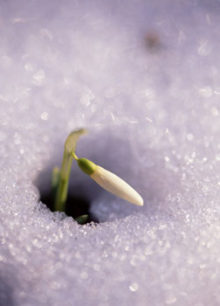 You can either take a walk to a favorite place, where you will be able to appreciate the changes around you, or as this is a time of new beginnings, it can be interesting to take a new route. Whichever your choice, take with you a small amount of spring water, or collected rain water. As you go, take care to notice the signs of new life and growth and wherever you see new shoots, buds, or leaves sprinkle a few drops on the plant and give thanks to the Goddess.
You can either take a walk to a favorite place, where you will be able to appreciate the changes around you, or as this is a time of new beginnings, it can be interesting to take a new route. Whichever your choice, take with you a small amount of spring water, or collected rain water. As you go, take care to notice the signs of new life and growth and wherever you see new shoots, buds, or leaves sprinkle a few drops on the plant and give thanks to the Goddess.
If you should come across a well or a spring, take the time to make an offering to the waters within. If you have finished the water you brought then your offering should be something which will not contaminate the water in any way. Where a tree grows close to this water you can also tie a single hair to one of its branches and ask for a Blessing for yourself or someone close to you.
If you should be lucky enough to pass grazing land look out for the first lambs of the year. If you see your first lamb of the year on this day you can make a wish.
As this is a time of new life and growth, it is appropriate to plant bulbs or flowers or to sow seeds. However, you will need to use your judgement and some local knowledge to decide whether to actually do so at Imbolc or whether to wait a week (or several) until the last frosts have passed. Of course seeds can often be started indoors and planted out a month or so later.
A word of caution here – if you are unlucky and your seedlings or plants fail, try not to read anything ‘significant’ into this. Unless and until you are an experienced and seasoned gardener, or unless you naturally have ‘green fingers’ you are quite likely to have a less than impressive success rate the first few times.
If you don’t have access to a garden, you can always choose an indoor plant to nurture. Many of the herbs that Witches use in their Magic, as well as their kitchen, will grow quite happily on a window sill. Rosemary and lavender are perhaps the two most useful, as well as having a pleasant scent all year round.
Celebrating Imbolc can be as easy as saying a prayer or as complicated as doing an elaborate ritual. The thing to remember is that it be meaningful and done with intent. Remember also that the Imbolc season runs through the actual day of Imbolc until the Spring Equinox; if you miss the exact day, you haven’t missed out on celebrating. The following is a list of activities to do alone, with a partner, or with your child to honor nature and deity as we travel ever closer to spring. Continue reading
In Celtic times the day was considered to begin at dusk the preceding night, so all major celebrations would commence the night before the day of the festival, much as New Year festivities start on New Year’s Eve.
Also called Imbolg, Oimelc and Candlemas, this is the festival of Bride or Bridget. It celebrates the Goddess’s transformation from Crone to Maiden and heralds the coming Spring and the change from dark to light. One of the ways to celebrate this is with a Circle of lights.
The dates given for this sabbat vary. On some calendars it is given as Feb 1st and on others Feb 2nd. I think the confusion might possibly stem from this practice of commencing the celebration the night before.
Everyone gathers in a Circle, lit only by a single black candle; the wick should be trimmed to give the smallest of flames. Each person has an unlit white candle. When everyone is ready someone says:
“This is the festival of Imbolg and the first signs of returning life tell us that Spring is on its way.
Let us light the path for the new season and say farewell to the old.
Blessed Be.”
They light their white candle from the black one, state something they wish for in the coming season, and extinguish the black candle. Going around the group Deosil (clockwise), each person states their own hopes and lights their candle from that of the person next to them. When all the candles are lit, everyone says together:
“We welcome the Goddess as Maiden,
We welcome the signs of new life.
We welcome the coming Spring.”
The candles can be placed somewhere safe to burn whilst everyone enjoys a feast or, if this is not a family celebration, they may be extinguished and taken home to bring Spring into everyone’s homes.
From: The Real Witches’ Year
Yule occurs on the Winter Solstice. This is the time of year when the sun is at its lowest point in the sky (Northern Hemisphere) and the Sun enters the sign of Capricorn. This usually happens between December 20th and December 23rd. Also known as: Alban Arthuan, the Winter Solstice marks the longest night of the year.
The word Solstice means “standing-still-sun” because the sun seems to stand still for this one day before the daylight begins to grow again. The sun will only rise higher and higher in the sky from this point onward. It is from this point that the days begin slowly to become longer and longer. The sun is at its most southeastern point over the Tropic of Capricorn in the northern hemisphere and has no apparent northward or southward motion. Since it appears that the sun’s light is growing as each day passes after this one, this holiday is celebrated as the birth of the sun.
The word Yule comes from the Old Norse “iul,” meaning wheel ,and refers to the ‘wheel of the year’, (or the idea of the year, seen as a wheel turning as the seasons change).
To our ancestors, the Sun was often identified with God, and the earth and moon with the Goddess. Since it was at this time that the daylight began to grow, our ancestors believed that this was the day the Goddess gave birth to the ‘sun-Son’. In the time of the ancient tribes this was a time of celebration, for it meant the turning point of winter and the eventual return of spring. Yule is the time when we honor the Goddess for giving birth to the sun once more. It is the time when the Oak King is victorious over the Holly King.
The Holly King represents death and darkness that has ruled since Samhain, and the Oak King represents rebirth and life. The waning (diminishing) sun is overtaken by the waxing (increasing) sun, thus the days become longer after the victory of the Oak King.
Yule is a time when we do Rituals and celebrate the increasing daylight, to renew, and to see the world through the eyes of a child. Spells done at Yule tend to raise our spirits, and bring harmony, peace, and joy. During Yule we see the wisdom of past experience begin to glimmer. The experiences we yielded over the harvest season of the times gone past begin to be reborn as wisdom, new light, to guide us further down the Paths we have chosen.
Because His birth heralds the days growing longer, the God represents hope in the coming cold of Winter and the promise that spring lies ahead. Since we are still in the coldest part of the year, with much cold and darkness still ahead of us, we should emulate the newly born baby. The baby Son draws close to his mother (the Goddess) at this time… we too must draw inward and be thankful for the family we have to help us through the hardships. This is also a time to delve into the depth of your mind and really look at yourself and see what you have learned in the past year.
Yule Traditions and Symbols
It is customary for Witches to decorate the Yule tree, and adorn the house with holly, ivy and pine. It is time when Father Winter, a white bearded chap dress in red, fur trimmed robes, arrives bearing gifts and exchange gifts.
This is the eve when the Yule log from the previous year is burned in the fire. Symbolic of the newborn sun, each year’s Yule log is of oak, charged in a Magic Circle and kept in sacred space the following Yule. This not only celebrates the oak and places it in a place of distinguished honor, but also ensures there will be fuel for the remainder of Winter.
Kissing Under The Mistletoe – Kissing under the mistletoe was first associated with the Greek celebration of Saturnalia and because it was believed to have the power of bestowing fertility, it became associated with marriage rites. In some parts of England, the Christmas mistletoe is burned on the Twelfth Night because it was believed that if it were not burned, all those who had kissed beneath it would never marry. And did you know that originally the custom was that a man should pluck one berry from the mistletoe each time he kisses a woman under the mistletoe, and when the last berry is gone, there should be no more kissing! (Information from Sara Williams)
Leaving Cookies for Santa – The ancient Celtic peoples left offerings of seeds, oats and oatcakes for the “wee people” and for the Gods or Goddesses of the different tribes. This practice evolved into the modern practice of leaving milk and cookies for Santa Claus.
Decorating The Yule Tree – In ancient times, the tree was decorated with symbols of the gifts the people wanted to receive from the Gods… Acorns, Oak Leaves, and Suns were representations of the Sun God. Birds and Bird Nests represented fertility as well as the return of the migrating flocks of birds in the Spring. Candles (and later, lights) were used to welcome back the Sun God and to encourage the sun to return. Crescent Moons and Silver Balls represented the Mother Goddess in her many forms Flowers, even the Poinsettia, represented the hope of the coming or Spring. Frogs, particularly Tree Frogs were for calling Spring back, since the call of the tree frog is one of the earliest signs of Spring. Fruit represented a bountiful harvest as well as the coming season of renewal and birth. Harps represented the continuity handed down by traveling Bards. Horns, drums and other musical instruments symbolized the ‘Blowing in the Yule’ and also represented the joyous music that welcomes the Sun God. Nuts represented a bountiful harvest. Toads, especially when hung upside down, were considered strong protection for the family.
Bells – Ancient Pagans rang bells during the Winter Solstice festivities to drive away demons that surfaced during the dark time of the year.* Also, the ringing of bells was thought to chase away the darkness so in some cultures, bells were rung in the morning as everyone rose to chase away the darkened days bring and heralding the warmer days.
Candles – Fires have been lit since ancient times to ward off the chill of Winter, chase away demons, and lure back the returning Sun (or son). * Candles were a useful way to have an ‘eternal’ flame while in the home. Also, many more candles could be lit than fires meaning more encouragement for the returning Sun.
Candy Cane – There is no denying that the Candy Cane has Christian roots… After all, an ingenious candy maker took an already existing candy – a straight white peppermint candy and bent the end of it to resemble a shepherd’s crook – since Jesus was the shepherd of men… or the letter “J”, for Jesus. He then placed a wide red stripe was to represent the blood Jesus shed on the cross, the three small red stripes were to represent his scourging, and the white of the cane was to represent the purity of Jesus and/or the forgiveness of sins his suffering bought for mankind.
However, Pagans have their own symbolism for the candy cane… The colors represent the God and Goddess (either as Red for the heat of the Sun and white for the coolness of the moon OR as Red for the blood shed by the mother while giving birth to the Sun God and white for the brightness of the Sun). The colors also represent the balance of the God and Goddess (or nature) since neither color is more prominent than the other color is. The peppermint is cool on the tongue (symbolizing the chill of winter), but has a bite to it, which is symbolic of the heat of the reborn Sun.
Elves – Elves first became associated with Yule because the ancients knew that the Spirits that created the Sun inhabited the land of Elves. By including elves in the Yule celebrations, the ancients believed they were assuring the elves assistance in the coercion of the Sun to return. Of course, since Father Christmas was patterned very closely after Odin, who was the King of the Elves, it makes sense that elves would be associated with him (and Christmas) also.
Evergreens – Evergreens were thought to have power over death because their green never faded. The evergreens were considered to be so powerful that they could defeat winter demons and hold back death and destruction. Because of their power and tenacity, evergreens were also believed to encourage the Sun’s return and were therefore placed around the home, both inside and out.
Gingerbread – Gingerbread was considered to be a specialty bread since ginger hadn’t ever been available until the Crusaders brought it back in the 11th century. There were strict laws regarding specialty breads in that time, so gingerbread was only allowed to be produced during Easter and Christmas. Since there was no Easter marketplace, it wasn’t long before gingerbread became associated with winter and Christmas.
Holly – The evergreen of the Holly leaves represents the hope of winter survival in celebrations of the winter solstice throughout the Old World. It is also, of course, representative of the Holly King (Father Christmas). The British consider the thorny-leafed holly to be male and the smooth-leafed holly to be female. Because of this, whichever variety is first brought into the home during the holidays determines which gender will lead the household during the coming year.
Mistletoe – The word ‘Mistletoe’ translates from its Anglo-Saxon origin into ‘dung-on-a-twig’. It came by this name because the ancient peoples observed that mistletoe would often appear on a branch or twig where birds had left droppings. (It was later discovered – in the sixteenth century – that the mistletoe seeds had been eaten by the birds and then sprouted after passing through the digestive tract and being deposited in the droppings). The mistletoe of the sacred oak was especially sacred to the ancient Celtic Druids and would be harvested on the sixth night of the moon with a golden sickle. Since it was gathered at Winter Solstice and it was seen as the ‘soul’ of the oak (and as a sexual symbol), the cutting of the mistletoe came to symbolize the defeat of the Oak King by the Holly King. It was hung from ceilings and place over doorways to ward off evil spirits (and to prevent witches from entering). (Information from Sara Williams)
Reindeer – Many people believe that reindeer are symbolic of the stags that drew Freya’s chariot. Of course, there is always the theory that there are 8 reindeer to represent the eight-legged steed of Odin (or the 8 Sabbats). Either way, it is easy to extrapolate that reindeer are a symbol of Cernunnos and that having horned creatures as a symbol of the day the Sun God is reborn is only fitting.
Santa Claus – Today’s Santa is a folk figure with multicultural roots. He embodies characteristics of Saturn (Roman agricultural god), Cronos (Greek god, also known as Father Time), the Holly King (Celtic god of the dying year), Father Ice/Grandfather Frost (Russian winter god), Thor (Norse sky god who rides the sky in a chariot drawn by goats), Odin/Wotan (Scandinavian/Teutonic All-Father who rides the sky on an eight-legged horse), Frey (Norse fertility god), and the Tomte (a Norse Land Spirit known for giving gifts to children at this time of year). Santa’s reindeer can be viewed as forms of Herne, the Celtic Horned God. Decorate your home with Santa images that reflect His Pagan heritage. Information from Selena Fox.
Tinsel – The tradition of placing tinsel on the tree comes from an old legend. Apparently, spiders were not allowed near the Yule tree – not even close enough to get a peek of it. Needless to say, this upset them greatly, so they complained. In some versions of the story they complain to the Christ-child, in others, they complain to the Goddess… either way, they were allowed admittance to the tree. Overjoyed by their victory, the spiders climbed around the tree, wrapping it in glistening webs. The Christ-child (or Goddess, depending on the story) was so delighted by their creativity that the webs were transformed into strands of silver (i.e. tinsel).
Tree – The custom of having a tree as a central focal piece in winter holiday celebrations can be traced back hundreds of centuries. The ancient Egyptians had a custom of bringing branches from palm trees into their homes on the shortest day of the year each December. The Chinese and Hebrews from ancient history had similar traditions, too.
Wassail – Wassail comes from the Old English words waes hael, which means “be well,” “be hale,” or “good health.” A strong, hot drink (usually a mixture of ale, honey, and spices) would be put in a large bowl, and the host would lift it and greet his companions with “waes hael,” to which they would reply “drinc hael,” which meant “drink and be well.” However, the ritual of ‘wassailing’ consisted of saluting the fruit trees and then sprinkling them with a bit of the wassail drink (which consisted of wine, ale, or cider with apples and eggs blended in)
Wreaths – The wreath’s circle symbolizes the wheel of the year and the completion of another cycle. Wreaths are hung as decoration and given as gifts to symbolize the infinity of goodwill, friendship, and joyfulness.
Yule Log – The custom of burning the Yule log began with the ancient Scandinavians who burned a huge log in honor of their god Thor once a year. For the Vikings, the yule log was an integral part of their celebration of the solstice, the julfest; on the log they would carve runes representing unwanted traits (such as ill fortune or poor honor) that they wanted the gods to take from them. Even as the Christian religion filtered into Scandinavia, the custom of the Yule log remained. The log was thought to bring blessings if it lasted 24 hours. It was also thought that the longer the Yule log burned the faster the Sun would come to warm the earth. Individuals would keep an unburned part of the log to light the next year’s Yule log. This unburned portion was also thought to bring good luck as well as protect the home from lightning and fire during the year.
Spell craft of Yule:
Spell craft performed for Yule should be for peace, harmony, love, and increased happiness.
Activities for Yule:
Caroling, wassailing , burning the Yule log, decorating the Yule tree, exchanging of presents, kissing under the mistletoe, feeding of animals and/or birds with grains and seeds
The God of Yule:
Frey – God, brother-consort of Freyja; son of Njord. “The Lord”, fertility and creativity God; “the Lover”; God of Yule. He is the god of wealth and peace and contentment. Blood was not allowed to be spilled through violence, nor where weapons or outlaws allowed on or in his holy places.
Other Deities:
- Apollo, Brighid, Demeter, Diana, Divine Child, Gaea, Great Mother, Green Man, Isis, Lugh, Mabon, Oak King, Odin, Ra, The Horned One
Symbols:
- A simmering pot of wassail, Baskets of clove studded fruit, Christmas cactus, Evergreen boughs or wreaths, Gold pillar candles, Holly, Mistletoe hung in doorways, Poinsettias, Yule log, or small Yule log with 3 candles
Herbs of Yule:
- Mistletoe: Magical Uses – Use to combat despair, herb of protection, child theft by fairies, healing, hunting, conception, to bring beautiful dreams, unlock the secrets of immortality through dreams – used for wands and ritual items or placed around a ‘Hand of Glory’ to ward off thieves – to protect the bearer from werewolves.
- Holly: Symbolizing – Protection; Good Luck. Forms used include boughs over portals, wreaths
- More Herbs: Bayberry, blessed thistle, laurel, pine, sage, yellow cedar, Bayberry. Blessed thistle, Evergreen, Frankincense, Holly, Laurel, Mistletoe, Oak, Pine, Sage, Yellow cedar.
Foods of Yule:
- Cookies and caraway cakes soaked in cider, Eggnog, Fruits, Ginger tea, Nuts, Pork dishes, Spiced cider, Turkey, Wassail, or lamb’s wool (ale, sugar, nutmeg, roasted apples).
Incense of Yule:
- Bayberry, Cedar, Cinnamon, Pine,
Colors of Yule:
- Green, Red, White, Gold, Silver, Yellow, Orange
Stones of Yule:
- Diamonds, Rubies, Emeralds, Bloodstones, Garnets
Trees for Yule:
- Oak : Endurance, Strength, Triumph, Protection. Magical Uses – Abundance, fertility, longevity, protection, spiritual awareness while remaining fully rooted in the earth plane, it’s wood is used for staves and wands, use any parts for protective charms which bring healing. Acorns bring fertility and abundance. Plant in the dark of the moon to bring financial prosperity.
- Evergreens: Continuity of Life, Protection, Prosperity. Forms used include boughs, wreaths, garlands, trees.
- Yew : Last Day of Solar Year; Death
- Silver Fir: Winter Solstice Day; Birth.
- Birch: Month following Winter Solstice; Beginnings.
From: Mystic Moon Coven and other sources
